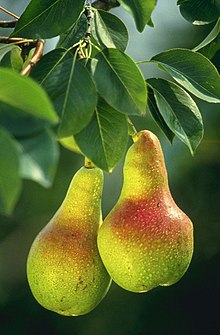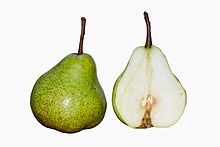**Botanical Information**:
– Pear is native to coastal and temperate regions of the Old World.
– It is a medium-sized tree, reaching 10–17m tall.
– Leaves are alternately arranged, simple, 2–12cm long.
– Flowers are white, 2–4cm in diameter with five petals.
– Pear fruit is a pome, with shapes varying from oblate to pyriform.
– Pear cultivation dates back to prehistoric times.
– Evidence of pear cultivation found in China as early as 2000 BC.
– Over 20 primary species of pear are recognized.
**Cultivars and Varieties**:
– Major species include European pear, Wild European pear, Chinese white pear, and Nashi pear.
– About 3000 known pear varieties are grown worldwide.
– Notable cultivars include Beth, Beurré Hardy, Beurré Superfin, Concorde, Conference, Doyenné du Comice, and Joséphine de Malines.
– Pear wood is used for fine furniture and woodcuts.
**Production and Harvest**:
– World pear production in 2022 was 26 million tonnes.
– China leads with 73% of total production.
– The Patagonian valley of Río Negro in Argentina produces 48% of Southern Hemisphere pears.
– Summer and autumn cultivars of Pyrus communis are gathered before fully ripe.
– Pear fruit is produced on spurs on shoots more than one year old.
**Storage and Uses**:
– Pears can be stored at room temperature until ripe.
– Refrigerated, uncovered storage extends shelf life to 2-3 days.
– Pears are consumed fresh, canned, as juice, and dried.
– Pear wood is preferred for woodwind instruments, furniture, and kitchen utensils.
– Pear purée is used in snack foods like Fruit by the Foot.
**Nutritional Information and Research**:
– Raw pears are 84% water, 15% carbohydrates, and a moderate source of dietary fiber.
– Contains vitamins B, C, E, and K, as well as minerals like potassium and calcium.
– 100g of raw pear provides 239 kilojoules (57 kilocalories) of energy.
– Preliminary evidence suggests pear consumption may impact cardiovascular health.
Pears are fruits produced and consumed around the world, growing on a tree and harvested in late summer into mid-autumn. The pear tree and shrub are a species of genus Pyrus /ˈpaɪrəs/, in the family Rosaceae, bearing the pomaceous fruit of the same name. Several species of pears are valued for their edible fruit and juices, while others are cultivated as trees.
| Pear | |
|---|---|

| |
| European pear branch with two pears | |

| |
| Pear fruit cross section | |
| Scientific classification | |
| Kingdom: | Plantae |
| Clade: | Tracheophytes |
| Clade: | Angiosperms |
| Clade: | Eudicots |
| Clade: | Rosids |
| Order: | Rosales |
| Family: | Rosaceae |
| Subfamily: | Amygdaloideae |
| Tribe: | Maleae |
| Subtribe: | Malinae |
| Genus: | Pyrus L. |
| Species | |
|
About 30 species; see text | |
The tree is medium-sized and native to coastal and mildly temperate regions of Europe, North Africa, and Asia. Pear wood is one of the preferred materials in the manufacture of high-quality woodwind instruments and furniture.
About 3,000 known varieties of pears are grown worldwide, which vary in both shape and taste. The fruit is consumed fresh, canned, as juice, dried, or fermented as perry.
